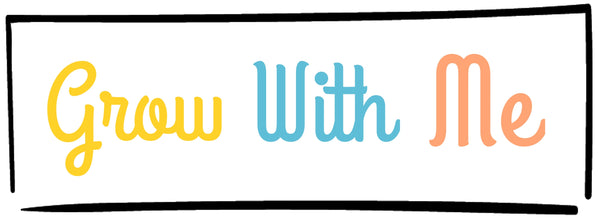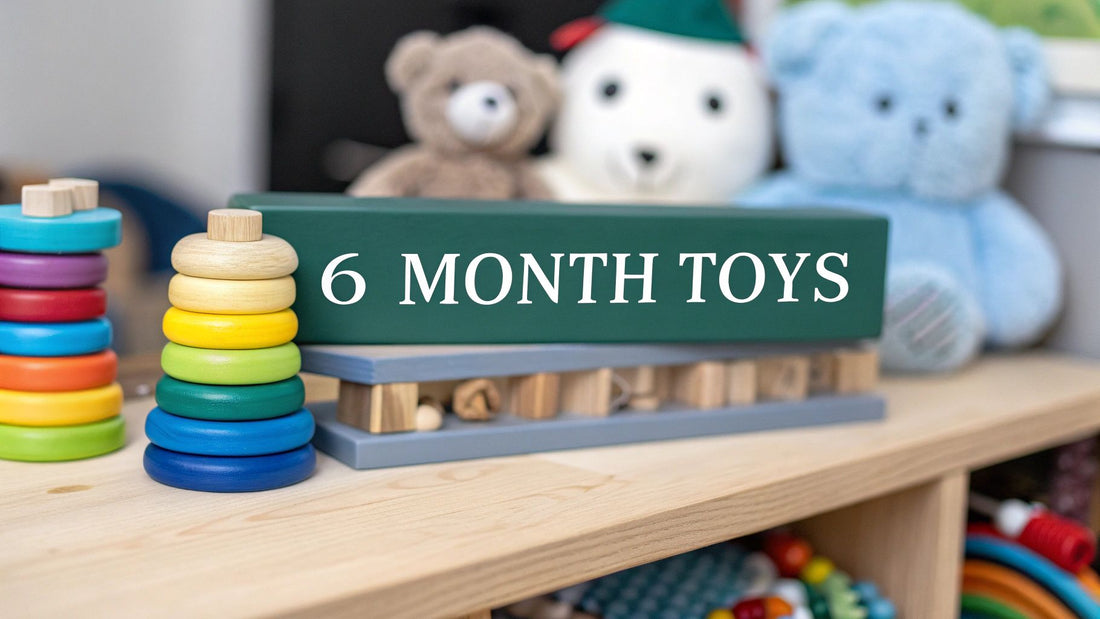
The Best 6 Month Toys for Baby Development
Share
The best toys for a 6-month-old are the ones that keep up with their incredible developmental pace. We're talking about toys that feed their curiosity through sensory exploration, build up their motor skills, and introduce them to the fascinating idea of cause and effect. Simple is often best—think textured balls, soft blocks, and safe teething rings.
The World Through Your Six-Month-Old's Eyes
Hitting the six-month milestone is like a switch flips. Suddenly, your baby isn't just a passive observer anymore; they're an active, hands-on explorer. Their world is bursting with new possibilities, and playtime is now a mission of purposeful discovery. This is when they start connecting the dots—realising their actions can make things happen. It’s the very foundation of all learning to come.
Try to see each toy less as a simple distraction and more as a tool for growth. When your baby finally manages to grab a soft block, it’s not just about holding something new. They're building the fine motor skills they'll need for life. And when they shake a rattle and hear that satisfying jingle? That's their first, brilliant lesson in cause and effect.
Understanding How Your Baby Learns Through Play
At this age, play is serious business. It’s your baby’s full-time job, and their main task is figuring out how the world works, from their own tiny hands to the colourful objects you put in front of them. The right toys for a 6-month-old are specifically designed to champion these crucial developmental leaps.
- Building Motor Skills: This is the age of big physical achievements. They're learning to sit up, reach for things with real intention, and pass toys from one hand to the other. Toys that encourage these movements are absolutely essential.
- Exploring with Their Senses: Babies are sensory learning machines. They understand their environment by touching, tasting, seeing, and hearing. Toys with different textures, gentle sounds, and bright, contrasting colours give them a rich sensory buffet to feast on.
- Sparking Cognitive Growth: Even a simple game like dropping a toy for you to pick up (over and over again!) is a mini-experiment. They're testing out early concepts like object permanence and learning the back-and-forth of social interaction.
This focus on developmental play isn't just a niche idea; parents everywhere are catching on. This shift is clearly reflected in the market, with the UK baby toys sector valued at roughly £650 million in 2024 and expected to grow even more. You can dive deeper into the data about the UK baby toys market to see just how much the demand for genuinely educational products is on the rise.
Why the Right Toys Make All the Difference
Choosing the right toy isn't about filling a toy box; it's about giving your baby safe and stimulating chances to practise their budding skills. It’s quality over quantity, every time.
Think of it like this: a simple set of stacking rings is a mini-gym for your baby's brain and body. It teaches them about sizes, sharpens their hand-eye coordination, and gets them problem-solving, all through the simple joy of play.
When you understand what's going on inside that rapidly developing mind, you can transform every playtime into a powerful learning moment, laying the groundwork for all the exciting milestones just around the corner.
Unpacking the Big Changes at Six Months
The six-month mark is truly magical. It’s not just one single leap forward; it’s a whole series of incredible breakthroughs happening all at once. Think of it like a builder laying the foundation for a house. Each new skill your baby masters is a crucial brick, setting the stage for more complex abilities down the line. Understanding these distinct milestones is the secret to choosing 6 month toys that don't just entertain, but actively support this amazing construction project.
From one day to the next, you’ll probably notice huge changes in how your little one interacts with the world. Their movements become more deliberate, their curiosity goes into overdrive, and their unique personality really starts to shine through.
This infographic gives a fantastic overview of the interconnected areas of development—motor skills, sensory exploration, and cognitive learning—that are blossoming right now.
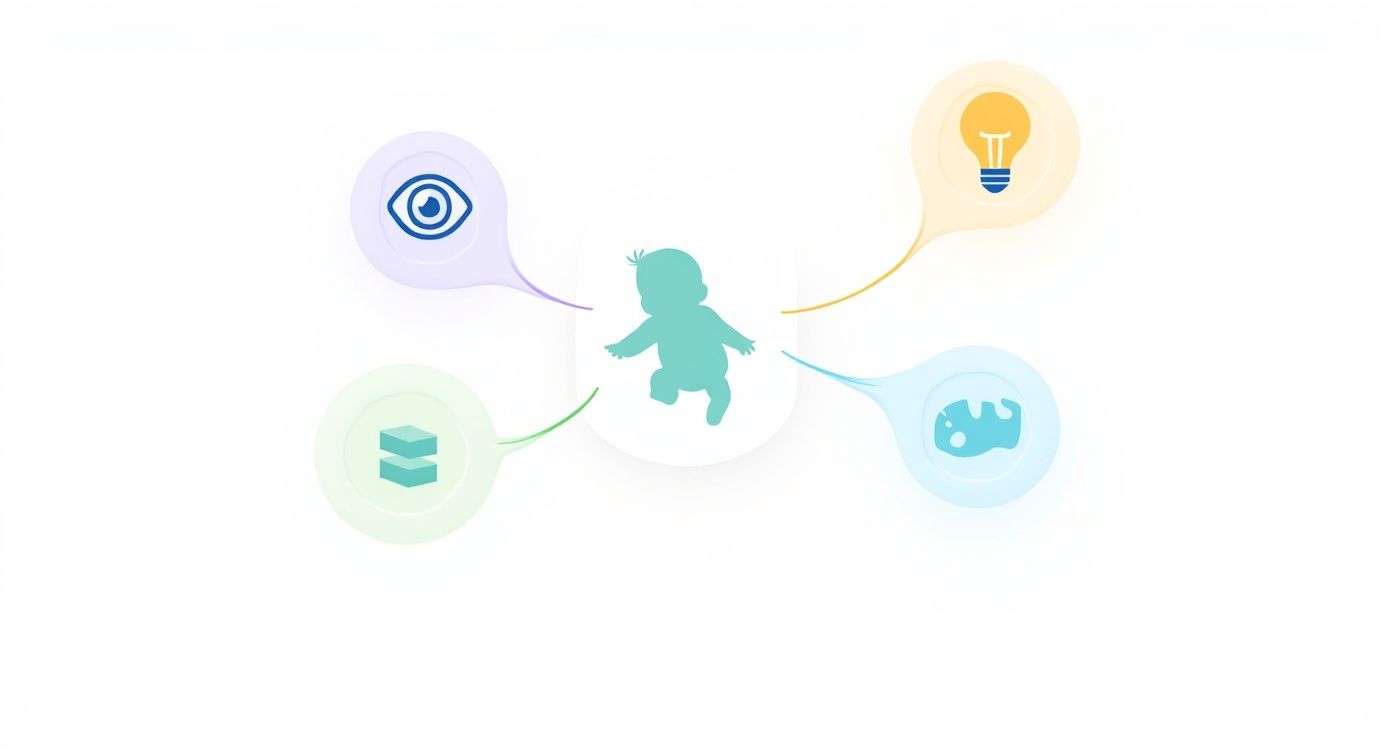
As you can see, these skills don't grow in isolation. They're all deeply linked, and you'll often find that a bit of progress in one area gives another a welcome boost.
Growing Stronger with Motor Skills
The most obvious changes are often physical. Your baby is gaining so much strength and control over their body, swapping those early wobbly movements for much more purposeful actions. The major triumph around this time is often sitting up on their own, even if it's just for a few moments. This brand-new upright perspective completely changes how they see and engage with everything around them.
Here are a few key motor skills you might be spotting:
- Sitting Up: They’re likely sitting pretty well with support and are busy strengthening those core muscles to sit independently.
- Reaching and Grasping: That reach is no longer a random swipe. They can now intentionally grab for a toy, often using a "raking" motion with their whole hand to pull it closer.
- Hand-to-Hand Transfer: You might notice them passing an object from one hand to the other. This is a huge sign of improving coordination and the two sides of their brain starting to work together.
- Rolling Over: Many babies have mastered rolling from their tummy to their back, and some are now working hard on the trickier back-to-tummy roll.
To help you connect these milestones with the right kind of play, here’s a quick-glance table.
Developmental Milestones and Supporting Toy Types at Six Months
| Developmental Area | Milestone Examples | Ideal Toy Characteristics |
|---|---|---|
| Gross Motor Skills | Sitting unsupported, rolling over, pushing up on hands. | Stable, low-to-the-ground toys like activity centres or play mats that encourage pushing and reaching. |
| Fine Motor Skills | Grasping objects, transferring items between hands. | Easy-to-hold toys with different textures, like soft blocks, teething rings, and graspable rattles. |
| Cognitive Development | Understanding cause and effect, developing object permanence. | Toys that react to baby's actions (e.g., rattles, musical toys) and simple "hide-and-seek" toys. |
| Sensory Exploration | Exploring with mouth and hands, responding to sounds. | Toys with varied textures, crinkly sounds, safe-to-chew materials, and bright, contrasting colours. |
| Social & Emotional | Babbling, mimicking sounds, recognising familiar faces. | Mirrors, soft dolls or puppets, and interactive books that you can explore together. |
This table shows how a single toy can often tick multiple boxes, supporting different areas of development all at once.
The Busy Mind of a Six-Month-Old
While their body is getting stronger, their mind is absolutely racing. Around six months, babies begin to grasp one of the most fundamental concepts in learning: object permanence. This is the brilliant realisation that things still exist even when they can't be seen. Suddenly, a simple game of peek-a-boo becomes a thrilling and hilarious lesson in this brand-new idea.
They are also starting to connect their actions with results. Shaking a rattle to make a noise isn't just a happy accident anymore; it's a deliberate experiment. This is the dawn of understanding cause and effect, a skill that forms the basis of all future problem-solving.
At the same time, their sensory and social skills are exploding. They’re exploring everything with their mouth—it’s their primary tool for learning about textures, shapes, and temperatures. Socially, they’re babbling with more intention, trying to mimic your sounds, and starting to clearly recognise familiar faces, strengthening those vital early bonds. Each of these milestones presents a perfect opportunity to introduce toys that match their current abilities while gently challenging them to reach for what's next.
How to Choose Safe and Stimulating 6 Month Toys
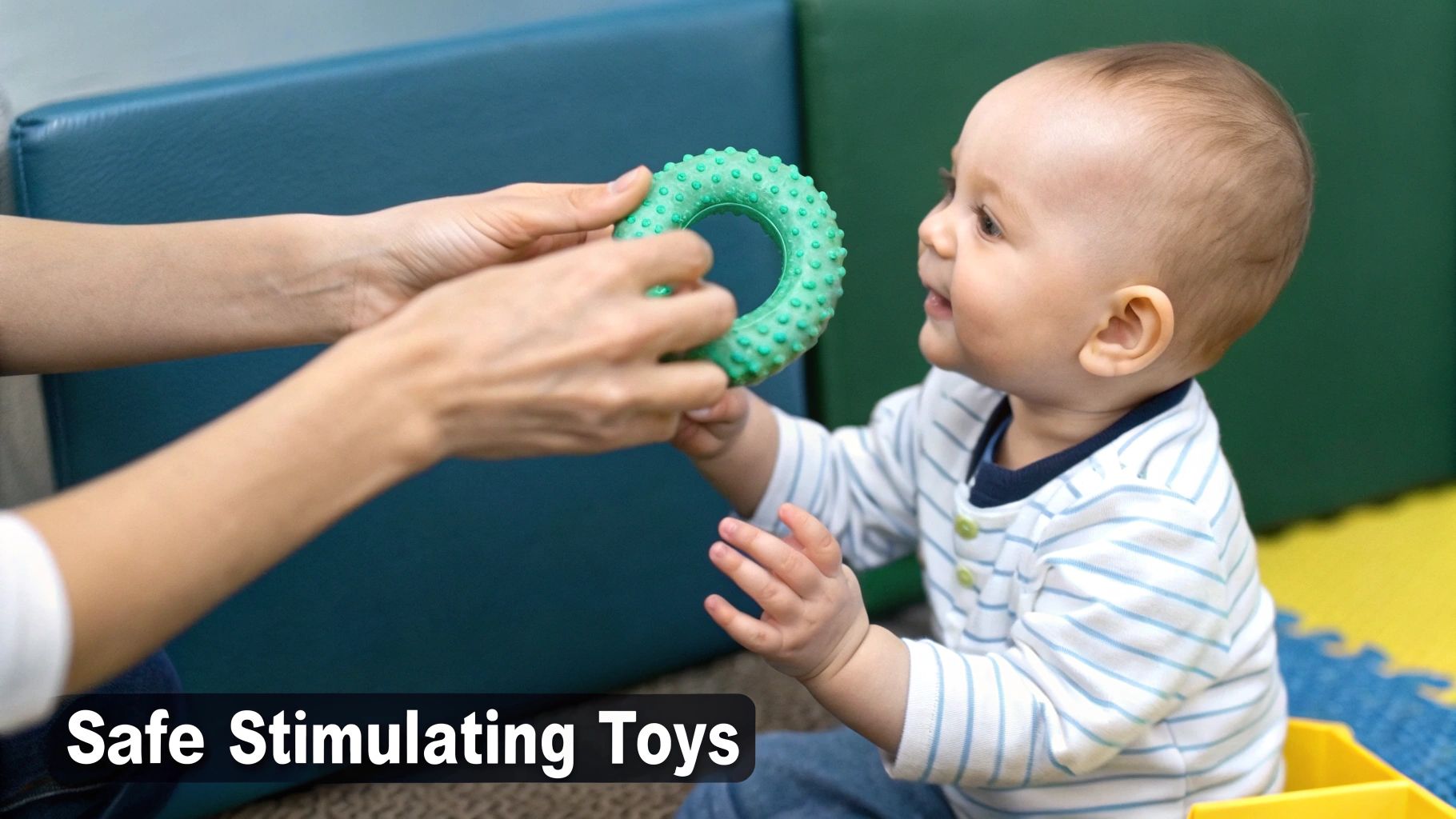
Now that we've got a good picture of what your little one is up to developmentally, let's get practical. Choosing the best 6 month toys really boils down to two things: making sure they're completely safe, and picking items that will actually captivate and help them grow.
Think of yourself as a curator for your baby's very first "hands-on" library. Each toy is a new book, a fresh chapter of discovery, and your job is to choose the best ones.
Prioritising Safety Above All Else
Before any toy can be fun, it absolutely has to be safe. At this age, a baby’s primary tool for exploration is their mouth. Everything—and I mean everything—will be gummed, chewed, and tasted, which is why safety is the one area where there’s no room for compromise.
Here’s a simple mental checklist to run through when you're looking at a new toy:
- Size Matters: Can the toy, or any piece of it, fit completely into your baby's mouth? A handy trick is to use an empty toilet paper roll. If a toy can pass through it, it's a potential choking hazard.
- Durable Construction: Give it a good look-over. Is it solidly built? Steer clear of toys with small, glued-on bits like button eyes or decorative gems that could easily come loose.
- Non-Toxic Materials: Always check the labels. You want to see phrases like BPA-free plastic, food-grade silicone, or untreated natural wood.
- No Cords or Strings: Avoid anything with long strings, ribbons, or cords. These can pose a serious strangulation risk and just aren't worth it.
Safety isn’t just about ticking boxes to avoid obvious dangers. It's about creating a totally worry-free space where your baby can explore freely, giving you the peace of mind to let them get on with it.
Looking for Toys That Stimulate and Grow
Once you've got the safety side covered, the fun can really begin. The best 6 month toys are the ones that fire up multiple senses and encourage your baby to get involved, rather than just sit back and watch.
You're looking for toys that invite your baby to be an active participant in their own learning. It’s no surprise that the demand for these kinds of toys is growing. The UK market for toys aimed at children up to five is set to expand, with a projected compound annual growth rate of around 4.5% between 2025 and 2034. It really shows how much parents are valuing these early learning tools.
What Makes a Great Developmental Toy
Instead of hunting for one "perfect" toy, it’s much better to build a small, thoughtful collection that covers a few key developmental areas. Look for simple items that encourage exploration and can be played with in lots of different ways.
A truly fantastic toy for a six-month-old often has these features:
- Multiple Textures: A mix of smooth, bumpy, soft, and firm surfaces gives their little hands and mouth plenty of new sensory information to process.
- Engaging Sounds: Gentle rattles, crinkly fabrics, or soft jingles are brilliant. They teach the fundamentals of cause and effect when your baby realises they are the one making the noise.
- Open-Ended Play: Simple classics like soft blocks or stacking rings are amazing. There’s no single "right" way to use them, which sparks curiosity and early problem-solving skills.
By pairing rigorous safety checks with a sharp eye for developmental features, you can confidently build a toy box that's not just entertaining, but a genuine partner in your baby’s incredible journey of growth. For a deeper dive into this, check out our guide on the benefits of developmental toys for infants.
Top Toy Categories To Nurture Your Baby's Growth
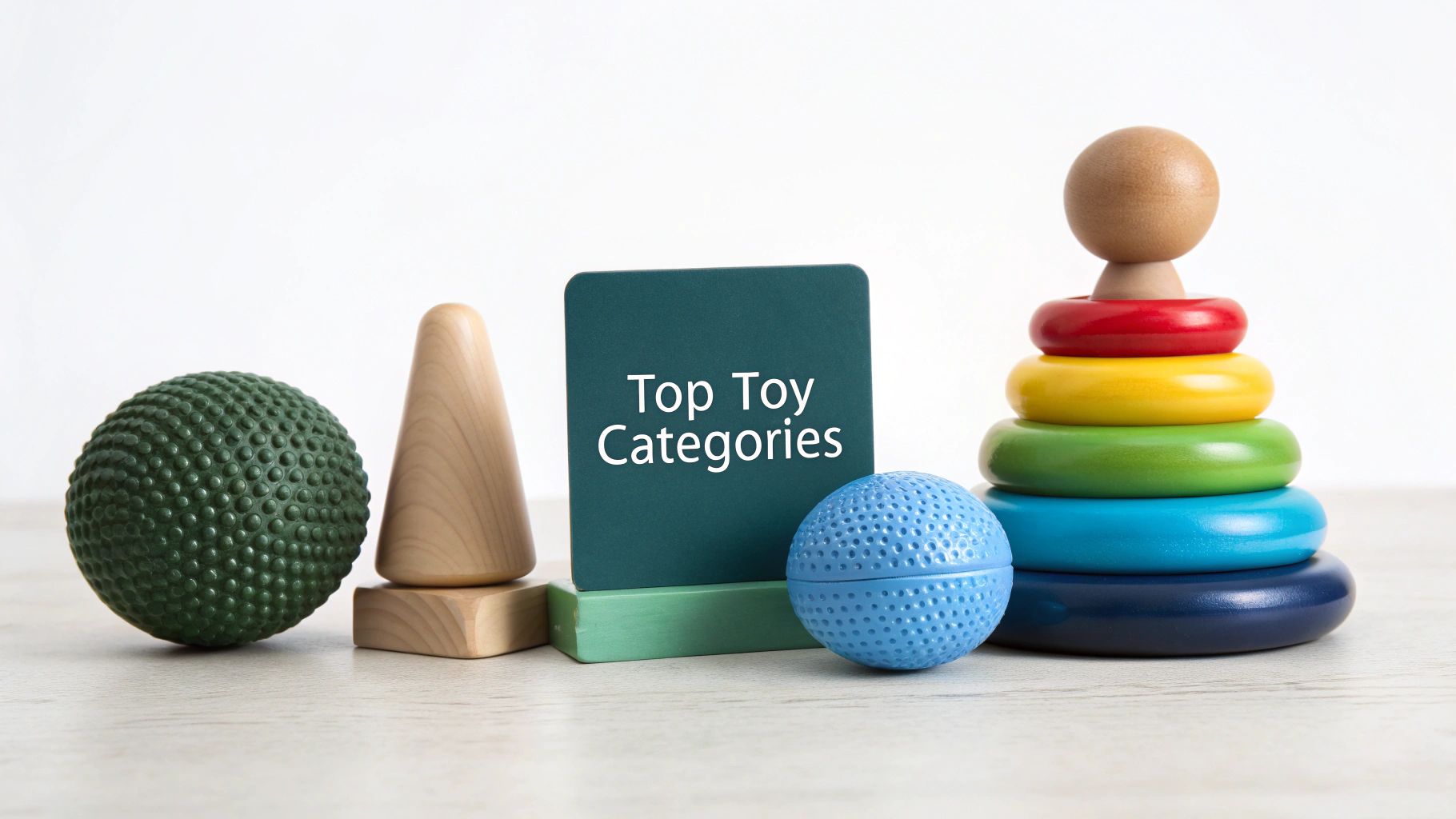
Now that you have a good picture of what your baby is working on and how to keep them safe, let's get to the fun part: choosing the best 6 month toys. It’s not about having a mountain of toys, but about building a small, thoughtful collection where each item helps them in a specific way.
This approach means you're not just buying stuff, but investing in their development. You'll be covering all the important bases, from helping them get stronger to sparking those early moments of discovery.
Sensory Toys for Hands-On Discovery
At six months, a baby’s world revolves around their hands and mouth. These are their main tools for exploration, which is why sensory toys are an absolute must-have. They're designed to tickle their developing senses of touch, sight, and hearing.
Look for toys with a mix of textures—bumpy, smooth, crinkly, soft. Think of a textured ball or a fabric book with different materials on each page. Every new sensation helps build vital pathways in their brain. If you want to dive deeper, our guide to the best sensory toys for babies is a great place to start.
A simple sensory toy is like a first handshake with the world. It introduces concepts like soft, hard, rough, and smooth, building a foundational vocabulary of touch long before they can say a single word.
Motor Skill Toys for Building Coordination
Your little one is working incredibly hard to gain control over their body. Motor skill toys are their workout buddies, designed to support both fine motor skills (like pinching) and gross motor skills (like rolling and sitting).
Classic stacking rings are a perfect example. Just trying to grasp a ring and get it onto the post is a brilliant exercise for hand-eye coordination. Soft, lightweight blocks are another winner, encouraging your baby to reach, grab, and practise passing an object from one hand to the other. These are the foundational movements for everything that comes later, from holding a fork to drawing a picture.
Teething Toys for Soothing Comfort
Around the six-month mark, those first little teeth often start to make an appearance. This makes teething toys less of a "nice-to-have" and more of an absolute essential for soothing sore gums!
But a good teether is more than just a comforter. It’s also a fantastic sensory and motor skills tool. Choose teethers made from safe, food-grade silicone or natural rubber with interesting textures your baby can explore with their mouth. Easy-to-grip shapes, like a silicone O-ball, also help them build their clutching skills while they find relief.
Cause-and-Effect Toys for a Thinking Mind
This is where you can almost see the cogs turning in their brain. Cause-and-effect toys teach your baby one of the most powerful lessons they will ever learn: "I can make things happen!"
- Rattles: The simplest form of this concept. When I shake it, it makes a sound. A profound discovery!
- Wobble Toys: A toy that rights itself when pushed teaches them about action and reaction.
- Activity Centres: Many have buttons that light up or play music when pressed, directly linking their touch to a fun result.
These toys are the very first step towards problem-solving and logical thinking. They show your baby that they are an active player in their world, not just a spectator.
Comparing Top Toy Categories for 6 Month Olds
To help you visualise how these different types of toys contribute to your baby's development, we've put together a simple comparison table. This can guide you in creating a well-rounded and engaging play environment.
| Toy Category | Primary Developmental Benefit | Example Toys |
|---|---|---|
| Sensory Toys | Engages senses (touch, sight, hearing) and builds neural connections. | Textured balls, crinkle books, fabric sensory panels, colourful mobiles. |
| Motor Skill Toys | Develops hand-eye coordination and strengthens muscles for movement. | Stacking rings, soft blocks, activity gyms, clutch balls. |
| Teething Toys | Soothes sore gums while promoting oral motor exploration and grasping. | Silicone or natural rubber teethers, teething rings, cooled teething toys. |
| Cause-and-Effect Toys | Introduces basic logic, problem-solving, and self-awareness. | Rattles, wobble toys, musical button toys, simple activity centres. |
This table shows that while each category has a primary focus, many toys overlap to support multiple areas of growth at once. The key is to offer variety, giving your six-month-old a rich and stimulating world to explore.
Understanding Toy Safety Standards in the UK
https://www.youtube.com/embed/nD-AeESN-4k
When you're choosing toys for a 6-month-old, safety isn't just a nice-to-have feature; it’s everything. Your baby is at that wonderful, curious stage where their mouth is their primary tool for exploration. This means you need absolute peace of mind that whatever they're gumming, grabbing, and dropping is completely harmless.
Thankfully, you don't have to be a safety expert yourself. In the UK, special markings on a toy's label do the hard work for you, showing that it’s passed a whole battery of rigorous safety tests.
Key Safety Marks to Look For
Think of these certifications as a safety passport. They're a promise from the manufacturer that the toy is legally and safely sold in the UK. Before you even think about colour or fun factor, these are the first things you should look for.
- The UKCA Mark: This is the UK’s own safety stamp of approval. When you see it, you know the toy meets all the essential health, safety, and environmental rules for Great Britain.
- The CE Mark: You'll still spot this one on plenty of toys. It's the European Union's equivalent, and it confirms the toy meets their high safety standards, which are also recognised here.
Finding one (or both) of these marks means the toy has been properly checked. It tells you it's free from nasty chemicals and has been designed to avoid common dangers like choking or sharp edges.
Spotting Common Hazards
Beyond the official labels, a bit of hands-on common sense goes a long way. At six months, babies are completely reliant on you to keep them safe, so learning to spot potential risks is a crucial skill.
Keep a sharp eye out for these red flags:
- Small Parts: The classic rule of thumb still works wonders. If a piece can fit through a toilet paper tube, it's a potential choking hazard for a baby.
- Long Cords: Any string, ribbon, or cord longer than 22 cm (that’s about 8.6 inches) is considered a strangulation risk.
- Harmful Materials: Look for reassuring labels like "BPA-free," "non-toxic," or "phthalate-free," especially on plastic or silicone toys that are likely to end up in your baby’s mouth.
Don’t forget that safety checks continue at home. Give toys a quick once-over before each playtime. Look for cracks, splinters, loose threads, or anything that looks broken. A toy that was perfectly safe yesterday could have a hazardous crack today.
Ultimately, these standards are all about trust. Toy makers in the UK take compliance seriously because they know parents need to feel confident in the products they buy for their children. It’s a commitment that helps safety standards shape the UK toy industry and ensures playtime stays fun and worry-free.
Common Questions About Toys for Six-Month-Olds
Choosing the right 6-month toys can feel like a big decision, and it’s completely normal to have questions. You're navigating a really exciting stage of your baby's growth, and you want to be sure you're giving them the best tools to learn and play.
To help you feel confident in your choices, we’ve put together answers to some of the questions we hear most often from parents. Think of this as your practical guide to building a thoughtful, effective toy collection for your little one.
How Many Toys Does a Six-Month-Old Actually Need?
It's tempting to think more toys mean more learning, but it's often the other way around. When it comes to your baby’s playtime, quality always wins over quantity.
A carefully chosen collection of just 5-8 toys is more than enough to keep them engaged. The trick is to select items that cover different developmental areas—things for sensory exploration, others for fine motor skills, and of course, a few for teething relief.
A fantastic strategy is toy rotation. Simply swap out a few toys each week to keep your baby’s environment feeling fresh and new. This simple habit encourages them to engage more deeply with each toy and stops them from feeling overwhelmed by clutter.
Are Electronic Toys with Lights and Sounds Good?
Electronic toys can certainly grab a baby's attention, but it’s best to use them in moderation. Toys that do all the work—with endless flashing lights and automatic sounds—can sometimes get in the way of a baby's own imagination and problem-solving skills.
If you do go for electronic toys, look for simple cause-and-effect features. A button that plays a short, simple tune when pressed is brilliant because it teaches your baby that their action caused a reaction. Try to steer clear of toys that are purely for passive entertainment. At this age, open-ended toys like soft blocks or stacking rings will always do more to encourage creativity and hands-on learning.
When Is the Right Time to Introduce Books?
Six months is the perfect time to start their literary journey! You can absolutely begin introducing books right away.
At this age, stick with soft cloth books or very sturdy board books. Look for ones with big, high-contrast pictures and interesting textures they can touch and feel. Reading aloud is one of the best things you can do for early language skills, even if they don’t understand the words yet. It’s more about the comforting sound of your voice and the sensory experience of the book itself. Plus, it creates a wonderful bonding moment you can share every single day.
Why Does My Baby Put Every Toy in Their Mouth?
Don't worry, this is not only completely normal but a crucial part of their development. At six months old, a baby’s mouth is one of their main tools for exploring the world around them. It has far more nerve endings than their hands, so "mouthing" is how they figure out different textures, shapes, and even temperatures.
This natural instinct is precisely why toy safety is non-negotiable. You need to be sure every toy is made from non-toxic materials and is too large to be a choking hazard. Providing a variety of safe teething toys can soothe their gums while satisfying this essential need to explore. If you're looking for more ideas, you can learn about great interactive toys for babies that are perfect for this hands-on (and mouth-on) stage.
At Grow With Me, we take the guesswork out of finding the perfect developmental toys. Our curated subscription boxes deliver age-appropriate, safe, and engaging toys right to your door. Explore our play kits today and give your baby the tools they need to thrive.
